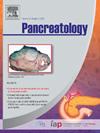基于深度学习的MRI扫描儿童胰腺分割。
IF 2.7
2区 医学
Q2 GASTROENTEROLOGY & HEPATOLOGY
引用次数: 0
摘要
目的:本研究旨在评估和验证PanSegNet,一种深度学习(DL)算法,用于急性胰腺炎(AP)、慢性胰腺炎(CP)和健康对照儿童的MRI胰腺分割。方法:经IRB批准,我们回顾性收集了Gazi大学(2015-2024)2-19岁儿童的84张MRI扫描图(1.5T/3T Siemens Aera/Verio)。该数据集包括健康儿童以及根据临床标准诊断为AP或CP的患者。儿科和普通放射科医生手动分割胰腺,然后由高级儿科放射科医生确认。使用Dice Similarity Coefficient (DSC)和第95百分位Hausdorff distance (HD95)对pansegnet生成的分割进行评估。科恩的kappa测量了观察者的同意度。结果:对42例AP/CP患儿(平均年龄11.73±3.9岁)和42例健康儿童(平均年龄11.19±4.88岁)进行胰腺MRI T2W扫描。PanSegNet的DSC评分分别为88%(对照组)、81% (AP)和80% (CP), HD95值分别为3.98 mm(对照组)、9.85 mm (AP)和15.67 mm (CP)。观察者间kappa为0.86(对照组),0.82(胰腺炎组),观察者内部一致性达到0.88和0.81。在自动和手动量之间观察到强烈的一致性(对照组R2 = 0.85,患者R2 = 0.77),证明临床可靠性。结论:PanSegNet代表了第一个经过验证的胰腺MRI分割深度学习解决方案,在健康和病变状态下实现了专家级的性能。该工具、算法以及我们的注释数据集在GitHub和OSF上免费提供,促进了无障碍、无辐射的儿科胰腺成像,并促进了这一服务不足领域的合作研究。本文章由计算机程序翻译,如有差异,请以英文原文为准。
Pediatric pancreas segmentation from MRI scans with deep learning
Objective
Our study aimed to evaluate and validate PanSegNet, a deep learning (DL) algorithm for pediatric pancreas segmentation on MRI in children with acute pancreatitis (AP), chronic pancreatitis (CP), and healthy controls.
Methods
With IRB approval, we retrospectively collected 84 MRI scans (1.5T/3T Siemens Aera/Verio) from children aged 2–19 years at Gazi University (2015–2024). The dataset includes healthy children as well as patients diagnosed with AP or CP based on clinical criteria. Pediatric and general radiologists manually segmented the pancreas, then confirmed by a senior pediatric radiologist. PanSegNet-generated segmentations were assessed using Dice Similarity Coefficient (DSC) and 95th percentile Hausdorff distance (HD95). Cohen's kappa measured observer agreement.
Results
Pancreas MRI T2W scans were obtained from 42 children with AP/CP (mean age: 11.73 ± 3.9 years) and 42 healthy children (mean age: 11.19 ± 4.88 years). PanSegNet achieved DSC scores of 88 % (controls), 81 % (AP), and 80 % (CP), with HD95 values of 3.98 mm (controls), 9.85 mm (AP), and 15.67 mm (CP). Inter-observer kappa was 0.86 (controls), 0.82 (pancreatitis), and intra-observer agreement reached 0.88 and 0.81. Strong agreement was observed between automated and manual volumes (R2 = 0.85 in controls, 0.77 in diseased), demonstrating clinical reliability.
Conclusion
PanSegNet represents the first validated deep learning solution for pancreatic MRI segmentation, achieving expert-level performance across healthy and diseased states. This tool, algorithm, along with our annotated dataset, are freely available on GitHub and OSF, advancing accessible, radiation-free pediatric pancreatic imaging and fostering collaborative research in this underserved domain.
求助全文
通过发布文献求助,成功后即可免费获取论文全文。
去求助
来源期刊

Pancreatology
医学-胃肠肝病学
CiteScore
7.20
自引率
5.60%
发文量
194
审稿时长
44 days
期刊介绍:
Pancreatology is the official journal of the International Association of Pancreatology (IAP), the European Pancreatic Club (EPC) and several national societies and study groups around the world. Dedicated to the understanding and treatment of exocrine as well as endocrine pancreatic disease, this multidisciplinary periodical publishes original basic, translational and clinical pancreatic research from a range of fields including gastroenterology, oncology, surgery, pharmacology, cellular and molecular biology as well as endocrinology, immunology and epidemiology. Readers can expect to gain new insights into pancreatic physiology and into the pathogenesis, diagnosis, therapeutic approaches and prognosis of pancreatic diseases. The journal features original articles, case reports, consensus guidelines and topical, cutting edge reviews, thus representing a source of valuable, novel information for clinical and basic researchers alike.
 求助内容:
求助内容: 应助结果提醒方式:
应助结果提醒方式:


